Written by Piney Kesting
Photographs courtesy of the
John F. Kennedy Center for the Performing Arts
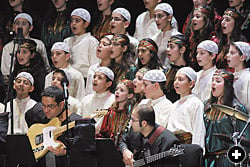 |
| CAROL PRATT |
| Headlining the three-week festival’s
opening with Byzantine, Muslim and
Arab songs, children of the Joqat
al-Farah (“Choir of Joy”) filled the
Eisenhower Theater with their voices. |
 s the lights dimmed and the
crowd hushed, not a seat was empty in the
Opera House of the John F. Kennedy Center
for the Performing Arts in Washington,
D.C. Honored guests included officials of
the Obama administration, the secretarygeneral
of the Arab
League, ambassadors,
cultural ministers and
diplomats from 22 Arab
nations. As Arab music
began to play, the doors
of the hall opened and
140 children of the
Al-Farah Choir of
Damascus, Syria ran
singing down the aisles.
Dressed in long, colorful robes, they waved
red and green scarves above their heads and
spilled onto the stage to provide an exuberant
opening for “Arabesque: Arts of the
Arab World,” the three-week festival of arts
and culture that brought 800 performers
from all 22 Arab nations to the United
States capital.
s the lights dimmed and the
crowd hushed, not a seat was empty in the
Opera House of the John F. Kennedy Center
for the Performing Arts in Washington,
D.C. Honored guests included officials of
the Obama administration, the secretarygeneral
of the Arab
League, ambassadors,
cultural ministers and
diplomats from 22 Arab
nations. As Arab music
began to play, the doors
of the hall opened and
140 children of the
Al-Farah Choir of
Damascus, Syria ran
singing down the aisles.
Dressed in long, colorful robes, they waved
red and green scarves above their heads and
spilled onto the stage to provide an exuberant
opening for “Arabesque: Arts of the
Arab World,” the three-week festival of arts
and culture that brought 800 performers
from all 22 Arab nations to the United
States capital.
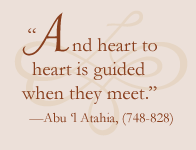 “I found myself tearing up when these
children performed,” confesses James
Zogby, president of the Washington, D.C.-
based Arab American Institute. “I never
expected to see the day when every single Arab country would be represented in
America’s premier institution for the
performing arts.”
“I found myself tearing up when these
children performed,” confesses James
Zogby, president of the Washington, D.C.-
based Arab American Institute. “I never
expected to see the day when every single Arab country would be represented in
America’s premier institution for the
performing arts.”
Oman’s ambassador to the United States,
Hunaina Sultan Al-Mughairy, echoes
Zogby. “I don’t think one can overestimate
the positive impact
of this event,
which celebrates
Arab culture,
being held in the
United States.”
After the
Al-Farah Choir’s
songs, the rest of
the opening-night
program delighted
the audience with a classical performance
by the Qatar Philharmonic Orchestra and
a performance by contemporary Lebanese
composer Marcel Khalifé and his sons.
There was a preview of Debbie Allen’s
“Oman…O Man!” commissioned especially
for “Arabesque,” and the finale came from
the keepers of one of the world’s oldest
musical traditions, the Moroccan Master
Musicians of Jajouka. In all, the February 23
opening was a “mezza”—a sampler—of the
musical cultures that would reverberate
throughout the center until March 15.
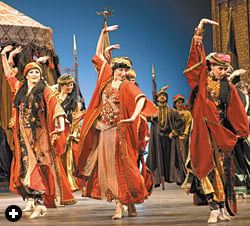 |
| CAROL PRATT |
| The Caracalla Dance Theatre, founded in
1968 in Lebanon, blended traditional
costumes, an original score and modern
choreography in “Knights of the Moon.” |
“When people talk about the Middle
East, they tend to think of one ‘Arab culture,’”
comments Nail Al-Jubeir, director of
information and congressional affairs at the
Royal Embassy of Saudi Arabia. Admitting
that he himself had never heard of Syria’s
Al-Farah Choir, Al-Jubeir emphasizes that
the festival exposed not only westerners
but also Arabs themselves to this diversity.
“Isn’t it ironic that the performers had to
come to Washington for us to get to know
each other?” he adds, laughing.
The seeds for “Arabesque” were planted
more than four years ago. “I believe the arts
create peace and provide a window onto
understanding people,” says Michael Kaiser,
president of the Kennedy Center. He explains
that since 2004, the Center has sponsored
festivals focused on France, China
and Japan; for 2009, he says, he wanted a
larger festival focused on regions about
which Americans have little cultural
knowledge. “In the Arab world, we know
only about politics and oil,” Kaiser comments.
“We have no knowledge of Arabs as
human beings. I felt it was important for us
to dispel this ignorance, and also to show
the immense beauty that has been created
by Arab people throughout the centuries.”
 |
| CAROL PRATT |
| K’Naan (left) grew up in Mogadishu during
the Somali civil war. Grandson of a
renowned Somali poet, he brought
his high-energy hope and protest
to “Arabesque.” |
Kaiser is the first to admit how little he
himself knew about Arab cultures before
the “Arabesque” project. “I knew what I read
in the newspapers,” he explains, adding that
the past four years have taken him and his
small staff on a “remarkable and challenging
journey.”
For the festival’s 21 days, visitors found
an open passport to the Arab world—no
visas required. There were daily performances
on several of the Center’s nine
stages; discussions of Arab literature with
more than 30 authors; Arab films; an exhibition
of 40 wedding dresses from all of the
22 Arab nations; contemporary art exhibits;
shopping in “The Souk” (“Marketplace”)
and learning about the Islamic world’s contributions to science
in the “Exploratorium.”
“Arabesque” is “an
idea that’s been a long
time coming,” says
Alicia Adams, vice president
of the Kennedy
Center’s international
programming and
“Arabesque” curator.
After 9/11, she explains,
the Kennedy Center
kept waiting for the
political situation to
improve. Arguing that
perhaps the best time to act is when things
are at their worst, Kaiser’s first step was
to reach out to the Arab nation ambassadors
in Washington and to the League of
Arab States.
“This has been a long and fruitful relationship,”
comments Dr. Hussein Hassouna,
the League of Arab States’ ambassador to
the US. Ambassadors from Arab countries
gave the project unanimous early support,
he says. Bader bin Saeed, head of the media
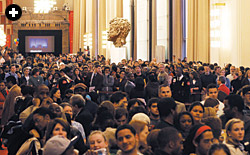 |
| Above: Lining up before show time,
some of the 4000 who filled the
Millennium Stage wait to hear the
free concert by hip-hop artist
K’Naan. Below: “Brides of the Arab
World” exhibited more than 40
masterpiece wedding dresses from
all 22 member nations of the
League of Arab States. |
 |
| CAROL PRATT(2) |
|
section of the embassy of the United Arab
Emirates, emphasizes that his country
believes that “the best vehicles for crossing
borders are arts and culture.” The festival,
he explains, “represents one of our first
opportunities to display our culture to this
wide an audience in the US.” Jordanian
ambassador Zeid Al-Hussein notes that the
festival “not only showcases samples
of Arab art and culture to Americans, but is
also about emphasizing our humanity and
shared values.”
For its part, the League of Arab States
served as the liaison between Kaiser and the Arab diplomatic community, and
League secretary-general Amre Moussa
signed the sponsoring agreement between
the Kennedy Center and the Arab League.
While Adams wore out her passport
traveling to more than 15 countries as she
scoured the region for artists, performers
and co-sponsors, Kaiser reached out to the
leaders of Arab organizations that, like the
Kennedy Center, promote the arts. In 2007,
the League of Arab States helped arrange a
two-day workshop in Cairo, taught by Kaiser,
for Arab arts
managers. (See sidebar below, “Exporting Expertise, Importing Art”) Some 140 arts
leaders from 17
Arab countries
attended.
During the
workshop,
George Ibrahim,
director of the
Al-Kasaba
Theatre and Cinematheque in the West Bank city of
Ramallah, invited Kaiser to view firsthand
the challenges in promoting arts in
Palestine. Kaiser visited Ramallah twice.
“I have developed a great affection for
Arab culture over these past few years,” he
explains. “I spend a lot of time in Palestine,
and I feel very much at home there.”
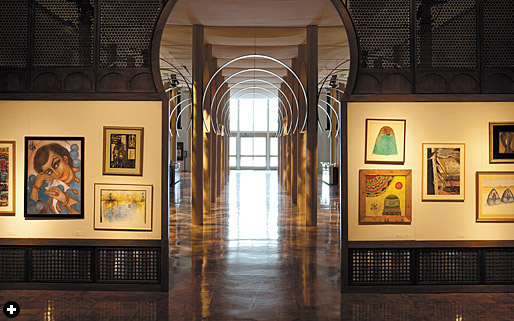 |
| MARGOT SCHULMAN |
| French exhibit designer Adrien
Gardère used architectural motifs
associated with the Arab world to frame
exhibits including “Breaking the Veils:
Women Artists From the Islamic
World.” |
|
At “Arabesque,” Al-Kasaba performed
“Alive from Palestine: Stories Under Occupation,”
both times to full houses and standing
ovations. Ibrahim explains that the play
is quietly powerful because each of the five
actors has written a monologue based on
his or her own real-life story. It changes
the way the audience looks at Palestinians,
he says: “We are not ‘news,’ we are human
beings like you.” Ibrahim feels that “Arabesque”
will be a success if people come
not to reinforce stereotypes “but to open
their hearts.”
 |
| MARGOT SCHULMAN |
| A 3-D film highlighting
Arab contributions to science played in
the Exploratorium. |
|
For her part, Adams discovered as she
traveled that despite—or at times perhaps
because of—the fraught climate between
Washington and the Arab countries, “everybody
was delighted to have an opportunity
to tell a different story and to put a new
face on the region.” Finding the right mix
between traditional and contemporary
performances and art for the exhibits was
essential. “Generally, I try to focus on the
contemporary, because I think it’s very
important for our audiences to see living,
breathing countries of the 21st century,”
she explains.
Once the performers were selected,
festival coordinator Gilda Almeida and her
two-person staff stepped up to arrange entry
visas, air tickets, ground transport, hotels,
chaperones, translators, identification
badges, insurance, instrument transport,
contracts and security—for all 800 performers.
“People come and buy tickets to the
events and they have no idea how much
work went into this,” she exclaims. “But
that’s the magic!”
Add to that effort the exhibits and the
market: Two tons of cargo shipped in,
including more than 60 delicately handcrafted
wooden mashrabiyyah screens from
Egypt, the 40 wedding dresses and designer
Azza Fahmy’s jewelry collection. “It’s
like pushing a hundred elephants every
day at the same time,” jokes Almeida. “But
when you see the looks on the artists’ faces,
and realize how important it is to them,
somehow you make it happen!”
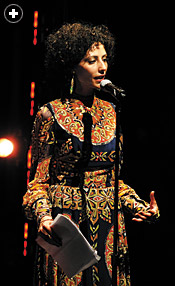 |
| REGIS VOGT |
| Above: Poet Suheir Hammad
performed “An Evening of
Breaking Poems” as part
of the festival’s literary program.
Below: Egyptian jewelry
designer Azza Fahmy brought
her blend of tradition and
innovation to the exhibit hall. |
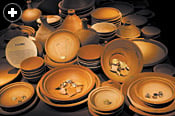 |
| MARGOT SCHULMAN |
|
The difficulty with exhibits that involve
22 countries, explains “Arabesque” exhibit
designer Adrien Gardère, is finding “a
common thread that emphasizes the legacy
and the roots that link the artists.” In
the case of the Kennedy Center, which is
neither a museum nor an exhibition hall,
“you want the exhibits to enhance the performing
arts and to capture the attention
of a public that has come primarily for the
performances,” he says. In less than eight
months, Gardère produced exhibits that used Islamic architectural elements and
proved as fascinating and provocative as
the artworks themselves.
Visitors entering the Kennedy Center
were captivated by a row of traditional
wedding dresses in the “Brides of the Arab
World” exhibit. Upstairs, Egyptian sound
engineer Alaa El Kashef ’s “Soundscape:
Souk” evoked a busy Cairo street. Nearby,
the exhibit of Azza Fahmy’s jewelry, a blend
of traditional and modern design, was displayed
nestled in stacks of unglazed clay
pots. Women’s art from throughout the
Middle East appeared in a room constructed
of mashrabiyyah windows—the traditional turned-wood screens that
allow in exterior light while
preserving interior privacy.
In the Exploratorium, visitors
lay back and watched a 3-D film on the golden
age of Islam, projected onto the ceiling.
By the end of the festival’s first week, ticket
sales for “Arabesque” stood 33 percent above the
Kennedy Center’s projections. Every performance
was either sold out or nearly so. The
daily free performances drew overflow crowds
that waited in line sometimes more than an
hour; in particular, Somalian hip-hop artist
K’naan drew a standing-room-only audience
of more than 4000 fans.
Caracalla, Lebanon’s first and most
prominent dance theater, was among those
performing to full houses. Director Ivan
Caracalla called “Arabesque” “a turning point. This is a history-making event
which will open up a new dimension,
both for Arabs and the American public.”
 |
| CAROL PRATT |
| Jordan-based fusion ensemble “RUM
– Tareq Al Nasser Musical Group” has
offered up its explorations of Arab and
western sounds to audiences in more
than 40 countries. |
|
Ethnomusicologist Kay Campbell, who
in 1997 co-founded the annual Massachusetts-based Arabic Music Retreat, is more
cautious. She questions whether “Arabesque”
can singlehandedly reinvigorate
an East–West creative fusion that was
beginning to flourish before 9/11. “Miracles
happen in quiet connections that people
make when the spotlight isn’t on,” notes
Campbell. She adds that the numerous
Arab and Arab–American cultural festivals
that began more than 20 years ago (see sidebar below, “Building Bridges”) remain critical to the ongoing
effort in the US to build bridges among
cultures. “The Kennedy Center festival is
important because it serves up the arts of
the Arab world on a silver platter, which,
in a way, gives the culture credibility,” says
Campbell. Her hope is that, with the Kennedy
Center’s imprimatur, the success of
“Arabesque” will encourage other presenters
to bring Arab culture to American
audiences nationwide.
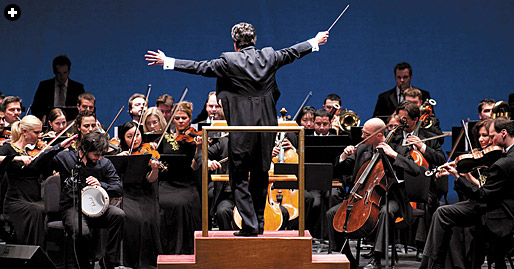 |
| MARGOT SCHULMAN |
| On the opening night of “Arabesque,” Andreas S. Wiser conducted the
Qatar Philharmonic. |
|
David Hamod, president and CEO of the
National US–Arab Chamber of Commerce,
agrees. “‘Arabesque’ represents a beginning,
not an end,” he says. “The next step is to
‘take the show on the road’ to communities
around the United States.
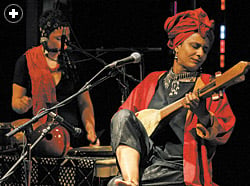 |
| CAROL PRATT |
| From the Comoros Islands off east Africa,
singer/songwriter Nawal blended Indian, Persian and Arab traditions with
east African Bantu polyphonies. She is the first woman musician from the
islands to give performances in public. |
|
If we hope to
improve the image of the Arab world in
the US, it will take a sustained, multi-year
commitment that will reach all walks of
American life.”
Kaiser notes that “Arabesque” is indeed
just the first of many steps. “We will be
bringing Arab culture here forever,” he
affirms. Kaiser explains that large festivals
attract much more attention from both the
public and the press. “We are not just trying to educate those who come: We are also
trying to educate those who don’t. This is
an important part of our strategy,” he notes.
“Twenty years from now, people will
look back at this event and say, ‘I remember
going to that,’” comments Arab American
Institute president Zogby. “Good seeds have
been planted, and they will grow.”

 he Kennedy Center probably has one of
the largest arts-education departments
of any performing-arts center in the United
States. We spend $25 million a year on arts
education, out of a $150-million budget,” says
Darrell M. Ayers, vice president of education at
the Kennedy Center. ”Arabesque” has given
quite a boost to the Center’s ability to offer
educators resources about the Arab world.
According to Ayers, teacher workshops
conducted in conjunction with the festival all
sold out. Renowned musician and composer
Simon Shaheen led two sessions that introduced
teachers to Arab music, and Zeina
Seikaly, director of educational outreach at the
Center for Contemporary Studies at Georgetown
University, guided three sessions titled
“Taste of the Arab World,” each focused
on the cuisine of a different country. Ayers
explains that “the objective is for all of these
resources to be used long after the festival
is over.”
he Kennedy Center probably has one of
the largest arts-education departments
of any performing-arts center in the United
States. We spend $25 million a year on arts
education, out of a $150-million budget,” says
Darrell M. Ayers, vice president of education at
the Kennedy Center. ”Arabesque” has given
quite a boost to the Center’s ability to offer
educators resources about the Arab world.
According to Ayers, teacher workshops
conducted in conjunction with the festival all
sold out. Renowned musician and composer
Simon Shaheen led two sessions that introduced
teachers to Arab music, and Zeina
Seikaly, director of educational outreach at the
Center for Contemporary Studies at Georgetown
University, guided three sessions titled
“Taste of the Arab World,” each focused
on the cuisine of a different country. Ayers
explains that “the objective is for all of these
resources to be used long after the festival
is over.”
 |
| ILAN MIZRAHI |
| “We can’t be a national leader without
being an international player,” says
Kennedy Center president Michael Kaiser. |
|
The part of the Kennedy Center’s education
department that looks outside the US is the
International Arts Management Program, initiated in 2001 by Kennedy Center president
Michael Kaiser when he stepped up
to the post. “We can’t be a national leader
without being an international player,”
he comments.
One aspect of the international program
is a nine-month fellowship that exposes 10
curators and directors of museums and performing-
arts programs abroad to the methods
of successful US arts organizations. There are
seminars with senior Kennedy Center staff,
three-month practical work rotations at the
Kennedy Center and a weekly strategic
planning seminar with Kaiser.
For Mohammed Abdallah, a program
coordinator at the Mawred Foundation, a
non-profit cultural organization in Cairo, the
fellowship was “an excellent opportunity to
be exposed to the American model of running
arts organizations.” Abdallah spent two work
rotations helping the Kennedy Center with
“Arabesque.”
Last year, the Center launched a subsequent,
four-week international summer
fellowship program with four of that year’s 10 fellows, from Egypt, Kuwait, Lebanon and
Palestine. This year, the summer program will
include eight from Arab League countries.
Kaiser devotes much of his time to teaching
arts leaders in the US and around the world how
to improve their organizations. “If you say
we need to use the arts to learn about other
people, you can’t then add ‘but not the Arab
people,’” says Kaiser. “There is tremendous
value to be gained from Arab and American
arts leaders working together. We hope to be
teaching in the Arab world forever, and we
hope American artists will find a home working
in the Arab world as well.”

 n March 13, 500 Girl Scouts from
the Washington, D.C. area were
in the audience for the world premiere of Oman...O Man! Written and choreographed
for “Arabesque” by Emmy Award winner
Debbie Allen, the production features 37
young dancers from Los Angeles, Washington,
D.C. and Oman who discover each
others’ cultures through dance and music.
n March 13, 500 Girl Scouts from
the Washington, D.C. area were
in the audience for the world premiere of Oman...O Man! Written and choreographed
for “Arabesque” by Emmy Award winner
Debbie Allen, the production features 37
young dancers from Los Angeles, Washington,
D.C. and Oman who discover each
others’ cultures through dance and music.
“One of the goals of the Girl Scouts is
to make our girls citizens of a multi-cultural,
international world,” explains Sabrina
McMillan, co-service unit manager for Girl
Scout Unit 42-1. “Leadership training, especially
for this generation, needs to focus on
problems among people.”
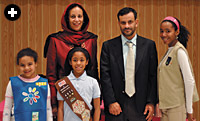 |
| RUBY ONG |
| Zoe Sinkford; Ambassador to
the United States from Oman Hunaina
Sultan Al-Mughairy; Madison Harris;
Sultan Qaboos Cultural Center Deputy
Director Mubarak Al-Busaidi; and Angela
Marsh-Coen. |
|
In 2008, McMillan’s troop held a
Muslim–Christian dialogue and invited
80 Muslim Girl Scouts to their Thinking
Day that year. When she learned about
“Arabesque” and the Allen production, she
decided that focusing on Oman for their
2009 Thinking Day festival would be “a
natural follow-up to the 2008 dialogue.”
More than 100 Girl Scouts from 22 local
troops took part in the February 13th
festival. The Sultan Qaboos Cultural Center
in Washington donated frankincense and
bookmarks, and tables displayed the Omani
flag and traditional dress and food, as well
as information on Girl Scouts in Oman.
“It was very rewarding to see firsthand
the girls’ interest in Oman and how it was
expanding their horizons and increasing
their understanding of the world,”
comments Omani ambassador Hunaina
Sultan Al-Mughairy, who visited the festival.
“This event, and attending ‘Arabesque,’
helps prepare the scouts to be international
citizens,” explains McMillan.

 thnomusicologist Dr. Ali Jihad Racy
of the University of California at Los
Angeles notes that in the US, one of the
earliest major cultural events to include
performers from the Arab world was the
1893 Chicago World’s Fair, also known as
the World’s Columbian Exposition, which
brought in entertainers from what was then
the Ottoman Empire. Singers, musicians,
belly dancers and actors from Egypt and
Syria filled the Cairo Pavilion, and one of the
favorite midway attractions was the “Street
in Cairo.” This was an eye-opener to the
American public, explains Racy, and it was
one of America’s first exposures to what
was then referred to as “the Orient.”
thnomusicologist Dr. Ali Jihad Racy
of the University of California at Los
Angeles notes that in the US, one of the
earliest major cultural events to include
performers from the Arab world was the
1893 Chicago World’s Fair, also known as
the World’s Columbian Exposition, which
brought in entertainers from what was then
the Ottoman Empire. Singers, musicians,
belly dancers and actors from Egypt and
Syria filled the Cairo Pavilion, and one of the
favorite midway attractions was the “Street
in Cairo.” This was an eye-opener to the
American public, explains Racy, and it was
one of America’s first exposures to what
was then referred to as “the Orient.”
In the Arab world, scholars, musicians,
composers and musicologists from across
the Arab world and Europe gathered in Cairo
in 1932 for the three-week Congrès du Caire.
Convened by Egypt’s King Fuad I, this was
the first cross-cultural conference held in
the Arab world. Fearing the decline of Arab
music, the king had charged the attendees
with its revitalization and preservation. As a
result, some 360 recordings made during the
congress are now in the sound archive of the
Bibliothèque Nationale de France in Paris.
Today, the history of these and many
subsequent cross-cultural festivals, both
in the US and in the Arab world, makes a
long and well-established list: The Brooklyn Maqam Arab Music Festival; the Arabic
Music Retreat in western Massachusetts,
now in its 12th year; the Aswat concerts
and Zawaya-sponsored festivals in California;
the ACCESS festivals in Dearborn, Michigan;
Chicago’s Global Fest; the International
Friendship Festival in Long Beach, California;
Jawaahir Dance Company in Minneapolis;
and the Berklee School of Music’s annual
Middle East Festival in Boston, among others.
In April 2005, Yarbous Productions in
Sharjah, United Arab Emirates, organized the
first Arab Festivals Networking Conference.
Nineteen festival directors from 13 Arab
nations were among the 100 participants;
they represented festivals in Bahrain, Byblos,
Madinah, Jerash, Marrakech, Jordan, Cairo,
Mawazin and elsewhere. The conference in
turn established the Arab Musical Festivals
Network, which today promotes intrafestival
cooperation, strengthens Arab–Palestinian
cultural links and promotes emerging Arab
arts and culture.
To this list we can now add “Arabesque”
as a new ambassador of good will and a new
affirmation, as Edward Said said, of “the
power of culture over the culture of power.”
 |
Piney Kesting is a Boston-based
free-lance writer and consultant.
Inspired by her first visit to
Lebanon many years ago, she has
been exploring and writing about
the Middle East ever since. Published
internationally, she is a frequent contributor
to Saudi Aramco World. |